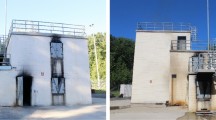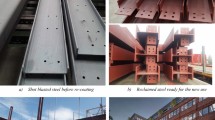Abstract
As before, the main trends in blast-furnace smelting in the Twenty-First Century are decreasing coke consumption, increasing furnace productivity, and lengthening of the furnace campaign. In the last few decades, the focus has increasingly been on extending the campaign through various technical, technological, and organizational measures. This article surveys the work done in these areas and analyzes the results of research performed by the world’s largest producers of pig iron.
Similar content being viewed by others
References
M. Naito, “Recent progress of practical blast furnace operations in Japan and innovative trials for the future,” Fifth European Coke and Ironmaking Congress, June 12–15, 2005, Stockholm, Sweden, Vol. 1, Mo 1:2.
V. Hille, R. Heber, and R. Rockstroh, “Blast furnace hearth lining technology for long life campaign,” ibid., Vol. 2, Tu 10:5.
S. Zhang and H. Yin, “Technological progress of China’s ironmaking after its annual tonnage surpassed 100 Mtons in 1995,” June 16–20, 2003, Dusseldorf.
D. I. van Lass, I. E. van Stein Calenfels, R. Stokman, et al., “Blast furnace refractories and cooling systems — the Hoogovens solutions,” Steel Times, 215, No. 10, 488–490, 503 (1987).
F. C. Rorick, E. D. Hague, and E. O’Donell, “Improvement of blast furnace operating results by reprofiling the furnace stack by robot shotcreting,” Fifth European Coke and Ironmaking Congress, June 12–15, 2005, Stockholm, Sweden, Vol. 1, Tu 10:2.
J. Tsalapatis and R. Keil, “The third campaign of the Whyalla No. 2 blast furnace,” ibid., Vol. 2, Tu 7:3.
L. Bonte et al., “Blast furnace hearth models, reline and cooling philosophies,” ibid., Vol. 2, We 7:3.
R. J. van Laar et al., “Blast furnace hearth management for safe and long campaigns,” Iron and Steelmaking Technology Conference Proc, April 27–30, 2003, Indianapolis, Indiana, pp. 1079–1090.
V. Koval’ski, Kh. B. Lyungen, and K. P. Shtrikker, “Durability of blast furnaces: current status, recent advances, and ways to extend the campaign,” Chern. Metall., Sept., 26–35 (1999).
D. S. Jameson, G. J. Tijhius, S. Kallo, et al., Fourth European Coke and Ironmaking Congress, June 19–22, 2000, Paris, France, Vol. 2, pp. 512–519.
T. Matsunaga, M. Kataoka, and I. Takita, “Densification of taphole clay for blast furnace,” Taikabutsu, 375–380 (2003).
B. Fraser, R. J. Nightingale, and R. Dwight, “Controlling sidewall growth at BHP’s No. 6 blast furnace at Port Kembla,” Ironmaking, 191–204 (2002).
J. Choi, K-W. Han, and B. R. Cho, “Long term high performance operation at Gwangyang blast furnaces,” La Revue de Metallurgie, Vol. 101, No. 3, 211, 213–218 (2004).
W. Hartig, K. Langner, H. B. Lungen, et al., “Measures for increasing the productivity of a blast furnace,” Fifth-Ninth Ironmaking Conference, March 26–29, 2000, Pittsburg, U.S. pp. 3–16.
P. Jesse, M. Henry, et al., “Hearth side wall carbon brick design performance,” Third European Ironmaking Congress, 1996. Belgium, pp. 274–277.
J. Dzermejko, “Blast furnace hearth design: theory, materials, and practice,” Iron and Steel Engineer, 68, No. 12, 23–31 (1991).
S. M. Justus and S. S. Cava, “Protection mechanisms of blast furnace hearth lining achieved through titanium additions to the burden,” L.E.B. Soledade. Interceram. Refractory Manual, No. 42, 60–65 (2003).
L. Oscar, V. Eduardo, et al., “Hearth wearing in Siderar blast furnace No. 2,” Fifth European Coke and Ironmaking Congress, June 12–15, 2005, Stockholm, Sweden, Vol. 2, Tu 7:4.
A. V. Terent’ev, S. K. Sibagatullin, and A. L. Mavrov, “Formation of a titanium crust in a blast furnace,” Izv. Vyssh. Uchebn. Zaved. Chern. Metall., No. 7, 15–16 (2004).
A. Ya. Kuzovkov, V. V. Filippov, V. S. Rudin, et al., “Extending the service life of the lining of blast furnaces by forming a titanium-bearing crust,” Stal’, No. 9, 31–35 (2001).
V. V. Filippov, A. Yu. Chernavin, V. A. Shatlov, et al., “Effectiveness of using titanium-bearing materials to reduce the wear of the lining of blast furnaces,” Chern. Metall: Byul. NTI, No. 10, 42–44 (2003).
E. E. Gavrilov and E. A. Shepetovskii, “Use of crust-forming additions to increase the service life of the hearth lining,” Stal’, No. 9, 16–18 (1989).
D. Bergsma and R. J. Furuehan, “Fundamentals of titanium-rich scaffold formation in the blast furnace hearth,” Ironmaking Conf. Proc. (2001), pp. 297–312.
A. G. Boon, G. Jimenez, and J. Castillo, “Titanium addition practice and maintenance for hearths in AHMSA’s blast furnaces,” Ironmaking Conf. Proc. (1997), pp. 321–326.
C. A. Klein and F. K. Fujihara, “Hearth wear control at CST’s No. 1 blast furnace aiming 25 years,” AISTech 2004 Proc., Vol. 1, pp. 47–55.
K. Spaleck, M. Schoeman, W. Seegers, et al., “Practices and design for extending the hearth life in the Mittal Steel Company blast furnaces,” Fifth European Coke and Ironmaking Congress, June 12–15, 2005, Stockholm, Sweden, Vol. 2, Tu 10:1.
J. Pethke, T. Stisovic, and P. Sylven, “New hearth lining direction at Salzgitter Flachstahl blast furnace B,” ibid., Vol. 2, Tu 10:4.
J. van Ikelen, R. Moleuar, and E. van Stein Callertals, “Reline of blast furnace No. 6 at Corus Ijmuiden, the Netherlands, ibid., Vol. 2, Tu 10:3.
V. N. Loginov, V. I. Neitronin, V. A. Shatlov, et al., “Use of titanium-bearing additions at the Severstal’ Company,” Proc. Seventh International Congress of Blast-Furnace Operators, September 9–12, 2002, Cherepovets, pp. 189–190.
V. V. Filippov, A. Yu. Chernavin, S. V. Shakhmin, et al., “Use of titanium-bearing wastes from blast-furnace smelting to protect the refractory lining of the blast furnace,” ibid., pp. 217–222.
K. Takeda, S. Watanabe, Y. Sawa, et al., “Prevention of hearth brick wear by forming of stable solidified layer,” Ironmaking Conf. Proc. (1999), pp. 657–665.
L. Bobek, D. Huang, et al., “Hearth wear and bottom skulls of Ispat Inland’s No. 7 blast furnace,” Iron and Steel Technology Conf. Proc., September 15–17, 2004, Nashville, Tennessee, Vol. 1, pp. 23–34.
Author information
Authors and Affiliations
Additional information
This article will be continued in the next issue of Metallurgist.
__________
Translated from Metallurg, No. 12, pp. 34–39, December, 2006.
Rights and permissions
About this article
Cite this article
Kurunov, I.F., Loginov, V.N. & Tikhonov, D.N. Methods of extending a blast-furnace campaign. Metallurgist 50, 605–613 (2006). https://doi.org/10.1007/s11015-006-0131-5
Issue Date:
DOI: https://doi.org/10.1007/s11015-006-0131-5




